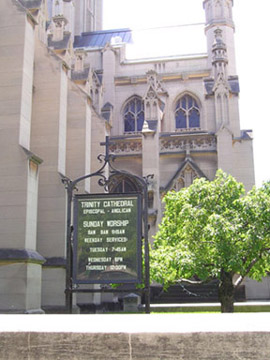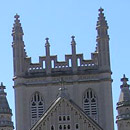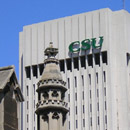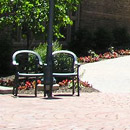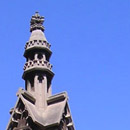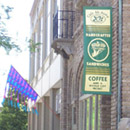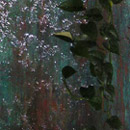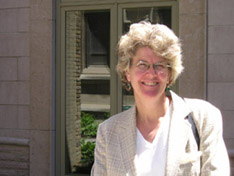
 |
|
 |
||
|
|
||||
|
||||

|
Church turned developer helps city reap a return By Lee Chilcote
Downtown churches don’t have it easy—just getting people in the pews on Sunday mornings can be a challenge. In many cases, parishioners move out of the city, but commute from the suburbs or another county. Few urban churches opt to tackle their location challenges through bricks and mortar. Most leave that to community development corporations (CDCs)—non-profit groups that tackle the tough task of redeveloping downtrodden neighborhoods. Nonetheless, Trinity Cathedral, one of Cleveland’s oldest and most historic churches located at East 22nd and Euclid Avenue, was faced with a choice: Build or perish. Spurring Trinity was a need for additional space for the church and the Episcopal Diocese, whose Northeast Ohio offices are headquartered here. But, at the center of the project was a prayer that the expansion would serve to revitalize a tired stretch of Cleveland’s old Grand Avenue. Euclid has lost considerable luster since the early 20th century when families like the Hannas and the Rockefellers were building extravagant mansions across the street. Then, Euclid was known nationwide as Millionaire’s Row, and Cleveland’s wealthiest, blue-blooded families built Trinity Cathedral, filling it with invaluable treasures, including stained glass from Tiffany Studios. Today, Millionaire’s Row is gone, replaced by Cleveland State University—an example of 1960s Brutalism with long stretches of poured concrete fortresses forming a panoptic prison. Trinity not only faced the challenge of rebuilding
within a street context that barely existed, it wanted to do everything
in an environmentally responsible fashion. The concept of a ‘green’
building was seen as an expression of spirituality through design
carried through even in the choice of tenants— community-based
retail with an ecological bent.
A third piazza faces Euclid next to several redeveloped storefronts, including Ah-Roma, a café that serves fair-trade coffee, tea, and hearty, healthy sandwiches and soups that are a cut above the fast-food offerings nearby. The café has brought life to this corner day and night. Next door is a bookstore, Sacred Paths, and Ten Thousand Villages, a non-profit that sells fair-trade handicrafts produced by third-world cooperatives. Standing on the inner piazza’s terrazzo floor inlaid with subtle religious symbols, one hears the hush of a fountain pouring water over a sheet of copper. From here, hallways shoot out like spokes – one leads to the Diocesan offices, another beckons towards the cathedral, and a third leads outside to a path lined with stepping stones and a courtyard filled with tables. The Commons was based on a plan to connect the architectural styles of three very different buildings. For more than one reason it’s also ‘green’— featuring recycled carpets, triple pane windows, energy saving electrical and plumbing systems, open spaces with natural light and a geothermal heating and cooling system. It’s more expensive, but “you have to look at the full cost of doing business,” insists Trinity’s Dean, Reverend Tracy Lind. “[It’s] not just the economic cost but the environmental cost. The energy savings will pay back in the long run.” The development is in stark contrast to the rest of
this stretch of Euclid Avenue, which is filled with low-end retail
and soulless institutional buildings. In total, the project cost
about $10 million. Trinity and the Episcopal Diocese invested $6
million from their endowment, and raised $4 million from parishioners.
“We need to look at opportunities to reconnect
with the community. Let’s build some space that the city can
use. Good stewardship mean[s] that if we only use the Sunday school
classrooms two hours per week, we shouldn’t let them be locked
up for the rest of the week.” As it turns out, Lind’s interview for the position of Dean at Trinity Cathedral was a turning point in the project. Although the development was underway with City Architecture heading up the design process, Lind's entrance helped to shape the Commons. “They asked me what my vision of an urban cathedral was, and I said, ‘it should be like a piazza,’” she recounts. “The first rule of St. Angela DeMarricci, a 16th century Italian woman who was a part of the Ursuline community, [is that] an urban cathedral should be open, vibrant and energetic. Paul Volpe, the principal architect at City Architecture, is Italian, so he understood piazzas.” City Architecture rose to the challenge of creating
the public space that Lind envisioned. If the vision came quickly, the work to see it through
was rife with challenge. First, the contractor encountered pipes
that needed to be replaced beneath the main parking lot. While excavating
for geothermal wells, crews ran into foundations from previous buildings.
Other challenges included replacing wooden roof trusses, and leveling
floors. Because delays in one layer of work affected the next, it
was tough to keep up with the project’s tight timeline.
If you’d never met Tracy Lind, you might ask, 'what does a church know about being a developer?' In this case, a lot. Before becoming a priest, Lind completed a Master’s degree in Urban Planning and worked for ten years in the field. While heading up a church in Patterson, New Jersey, she formed a spin-off community development corporation. She is as comfortable talking about loan amortization and streetscape design as scripture. “I think that one of the core missions of the church is community development,” says Lind, “so I’ve always combined my planning background with my ministry. "I’ve heard that CSU students spend seventeen
minutes on campus outside of classroom time. There’s no reason
to come outside – there’s nothing on Euclid. This is
a form of campus ministry, and promoting fair trade coffee and local
entrepreneurs is also something that we are committed to. This is
just the second location for Café Aroma, and all of the coffee
that they sell is either fair trade, organic or shade grown.”
Lind draws a link between the physical vitality of the city and its cultural and spiritual vibrance. “I believe the malls have become our main streets, and the mega book stores our churches and synagogues,” she says. “We live in a city with a high rate of depression, smoking and obesity. We’re not doing something right, and a part of that rightness is connectivity and energy. People are hungry to gather. They want places to have a conversation, buy a cup of coffee, sit for a while and read a book.” At this, a smile lights Lind’s face. “If, in the process of experiencing Trinity Commons, folks decide that they want to come to church—or to a synagogue or a mosque – then that’s great,” she says with a shrug. “People say to me all the time, ‘Is this really a church?’ We have five services here on Sunday. I tell them, ‘Come and see where we get the inspiration to do what we do. Come and see.’” |
"People are hungry to gather. They want places to have a conversation, buy a cup of coffee, sit for a while and read a book...”
—Tracy Lind
Once Upon a Rustbelt | Party Center | Raw Materials | Subscribe | Urban Underpants
